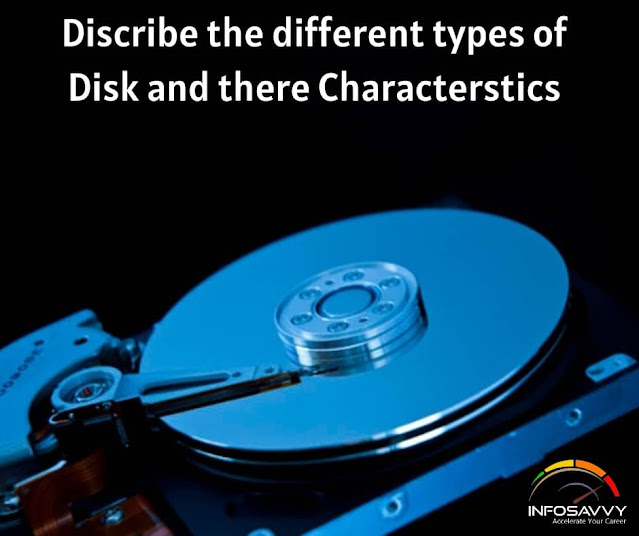Discribe the different types of Disk and there characterstics
In this article explain Discribe the different types of Disk and there characterstics & uses. Disk Drive is a digital data storage device that uses different storage mechanisms such as mechanical, electronic, magnetic, and optical to store the data. It is addressable and rewritable to support changes and modification of data. Depending on the type of media and mechanism of reading and writing the data, the different types of disk drives are as follows:
- Magnetic Storage Devices: Magnetic storage devices store data using magnets to read and write the data by manipulating magnetic fields on the storage medium. These are mechanical devices with components moving to store or read the data. Few other examples include floppy disks, magnetic tapes, etc.
In these types of hard disks, the disks inside the media rotate at high speed and heads in the disk drive read and write the data. - Optical Storage Devices: Optical storage devices are electronic storage media that store and read the data in the form of binary values using a laser beam. The devices use lights of different densities to store and read the data. Examples of optical storage devices include Blue-Ray discs, CDs, and DVDs,
- Flash Memory Devices: Flash memory is a non-volatile electronically erasable and reprogrammable storage medium that is capable of retaining data even in the absence of power. It is a type of electronically erasable programmable read only memory (EEPROM). These devices are cheap and more efficient compared to other storage devices. Devices that use flash memory for data storage are USB flash drives, MP3 players, digital cameras, solid-state drives, etc.
Few examples of flash memory are:
– BIOS chip in a computer
– Compact Flash (commonly found in digital cameras)
– Smart Media (commonly found in digital cameras)
– Memory Stick (commonly found in digital cameras)
– PCMCIA Type I and Type II memory cards found in laptops
– Memory cards for video game consoles
Related Product : Computer Hacking Forensic Investigator | CHFI
Hard Disk Drive (HDD)
Hard Disk Drive is a non-volatile, random access digital data storage device used in any computer system. The hard disk stores data in a method similar to that of a file cabinet. The user, when needed, can access the data and programs. When the computer needs the stored program or data, the system brings it to a temporary location from the permanent location. When the user or system makes changes to a file, the computer saves the file by replacing the older file with the new file. The HDD records data magnetically onto the hard disk.
The hard disks differ from each other considering various measurements such as:
- Capacity of the hard disk
- Interface used
- Speed in rotations per minute
- Seek time
- Access time
- Transfer time
Solid-State Drive (SSD)
A Solid-State Drive (SSD) is an electronic data storage device that implements solid-state memory technology to store data similar to a hard disk drive. Solid-state is an electrical term that refers to an electronic circuit entirely built with semiconductors.
It uses two memories:
- NAND-based SSDs: These SSID5 use solid state memory NAND microchips to store the data. Data in these microchips is in a non-volatile state and does not need any moving parts. NAND memory is non-volatile in nature and retains memory even without power.
NAND memory was developed primarily to reduce per bit cost of data storage. However, it is still more expensive than optical memory and HDDs. NAND-based memory is widely used today in mobile devices, digital cameras, MP3 players, etc. It has a finite number of writes over the life of the device. - Volatile RAM-based SSDs: SSDs, based on volatile RAM such as DRAM, are used when applications require faster data access. These SSDs include either an internal chargeable battery or an external AC/DC adapter, and a backup storage. Data resides in the DRAM during data access and is stored in the backup storage in case of a power failure.
This Blog Article is posted by
Infosavvy, 2nd Floor, Sai Niketan, Chandavalkar Road Opp. Gora Gandhi Hotel, Above Jumbo King, beside Speakwell Institute, Borivali West, Mumbai, Maharashtra 400092
Contact us – www.info-savvy.com




Comments
Post a Comment